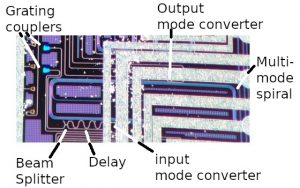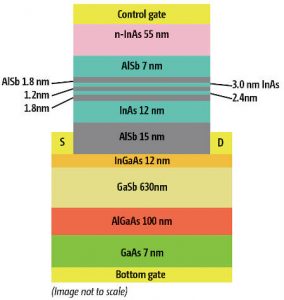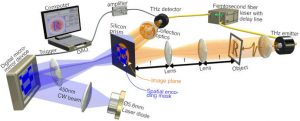In this category, visitors to the Electronics Weekly website are invited to select the University research project which they feel will make the largest impact on the commercial market in the next five years.
A shortlist of five university research projects has been selected by the Group Editor of Electronics Weekly: they are from (alphabetically) the Universities of Bristol, Lancaster, Oxford and Kings College London, Surrey and Warwick. Read the entries below and then cast your vote!
– VOTING NOW CLOSED –
Don’t forget that this year’s Elektra Awards will take place as a free virtual event on 25 March 2021 and tickets are now available – simply register here.
Making photons for quantum computing, on CMOS
 A team of physicists at the University of Bristol has used CMOS to integrate photon source suitable for “large-scale quantum photonics”, it said. “An important challenge that has limited the scaling of integrated quantum photonics has been the lack of on-chip sources able to generate high-quality single photons,” according to Bristol quantum engineer Stefano Paesani.
A team of physicists at the University of Bristol has used CMOS to integrate photon source suitable for “large-scale quantum photonics”, it said. “An important challenge that has limited the scaling of integrated quantum photonics has been the lack of on-chip sources able to generate high-quality single photons,” according to Bristol quantum engineer Stefano Paesani.
III-V memory saves power over DRAM and flash
 The University of Lancaster has taken a step forward with its novel non-volatile memory that can be written and erased for one hundredth of the energy needed by flash or DRAM. It is also fast enough to be used instead of DRAM. It is around 10-17J for a device with 20nm feature size. This tiny amount of energy was known last year, but now the structure has been refined to allow flash-like readout simplicity.
The University of Lancaster has taken a step forward with its novel non-volatile memory that can be written and erased for one hundredth of the energy needed by flash or DRAM. It is also fast enough to be used instead of DRAM. It is around 10-17J for a device with 20nm feature size. This tiny amount of energy was known last year, but now the structure has been refined to allow flash-like readout simplicity.
Developing ventilators that can be manufactured in SME workshops
 Engineers, anaesthetists and surgeons from the University of Oxford and King’s College London are building and testing prototype ventilators that can be manufactured using techniques and tools available in well-equipped university and small and medium enterprise (SME) workshops. The team, led by Oxford Professors Andrew Farmery, Mark Thompson and Alfonso Castrejon-Pita and King’s College London’s Dr Federico Formenti, have been working to define novel mechanisms of operation that will meet the required specifications for safe and reliable function. The design aims to exploit off-the-shelf components and equipment.
Engineers, anaesthetists and surgeons from the University of Oxford and King’s College London are building and testing prototype ventilators that can be manufactured using techniques and tools available in well-equipped university and small and medium enterprise (SME) workshops. The team, led by Oxford Professors Andrew Farmery, Mark Thompson and Alfonso Castrejon-Pita and King’s College London’s Dr Federico Formenti, have been working to define novel mechanisms of operation that will meet the required specifications for safe and reliable function. The design aims to exploit off-the-shelf components and equipment.
A battery-less, biodegradable, implantable, motion sensor
 Researchers at Surrey University and Kyung Hee University of Korea have developed a biodegradable motion sensor – paving the way for implanted nanotechnology. They developed a nano-biomedical motion sensor which can be paired with AI systems to recognise movements of body parts. The technology builds on previous work around triboelectric nanogenerators (TENG), where researchers used the technology to harness human movements and generate small amounts of electrical energy.
Researchers at Surrey University and Kyung Hee University of Korea have developed a biodegradable motion sensor – paving the way for implanted nanotechnology. They developed a nano-biomedical motion sensor which can be paired with AI systems to recognise movements of body parts. The technology builds on previous work around triboelectric nanogenerators (TENG), where researchers used the technology to harness human movements and generate small amounts of electrical energy.
THz video camera achieves 32 x 32 pixels at 6frame/s
 Terahertz video at 6frame/s and with 32 x 32 pixels has been achieved by a team led by Professor Emma Pickwell-MacPherson from the University of Warwick, working with the Chinese University of Hong Kong. “Their terahertz camera reached 100 times faster acquisition than the previous state-of-the-art without adding any significant costs to the system or sacrificing the sub-picosecond temporal resolution needed for the most sought-after applications,” according to the University of Warwick.
Terahertz video at 6frame/s and with 32 x 32 pixels has been achieved by a team led by Professor Emma Pickwell-MacPherson from the University of Warwick, working with the Chinese University of Hong Kong. “Their terahertz camera reached 100 times faster acquisition than the previous state-of-the-art without adding any significant costs to the system or sacrificing the sub-picosecond temporal resolution needed for the most sought-after applications,” according to the University of Warwick.
 Electronics Weekly Electronics Design & Components Tech News
Electronics Weekly Electronics Design & Components Tech News


